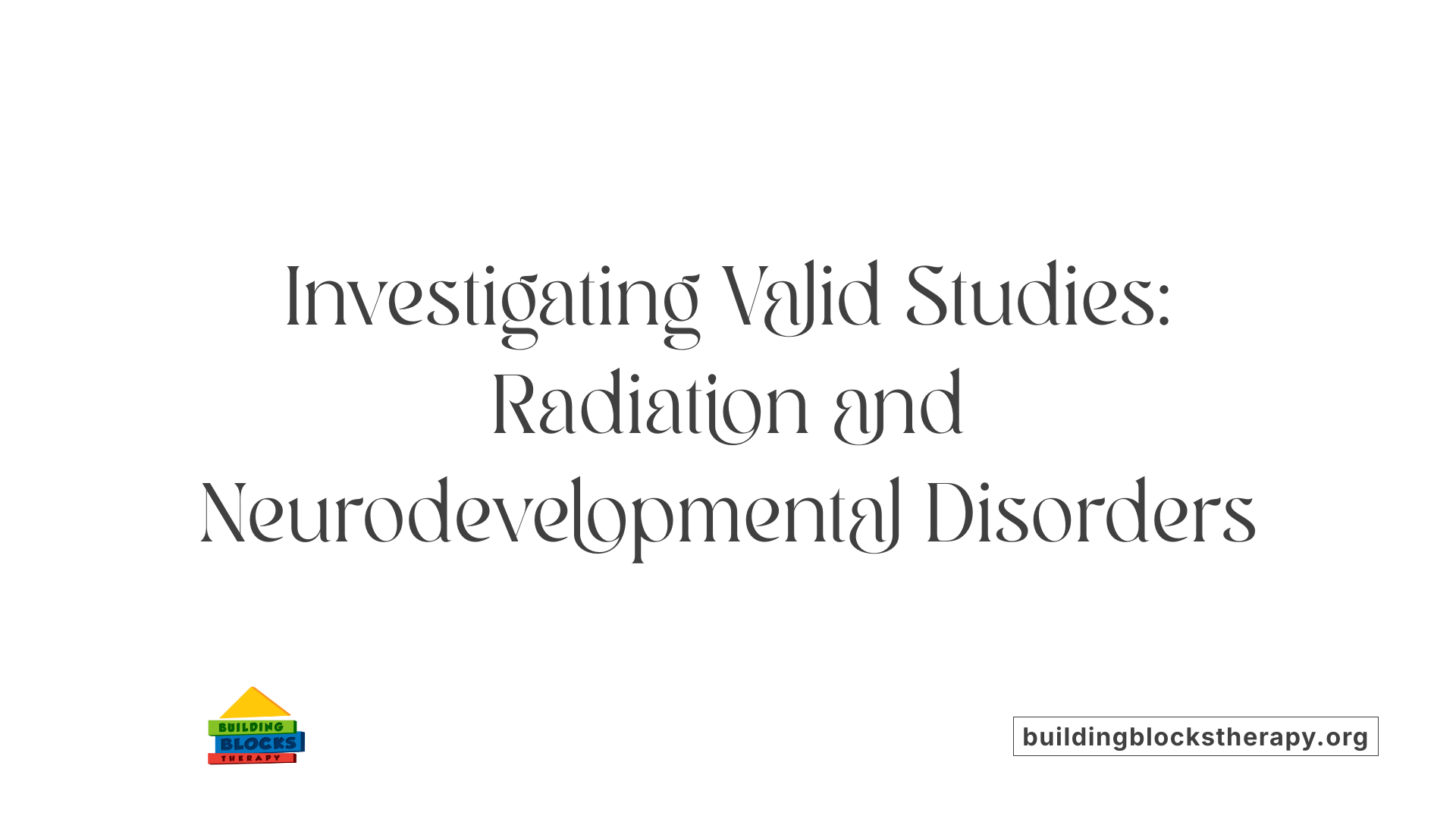Does Radiation Cause Autism?
Exploring the Complex Relationship between Radiation and Neurodevelopmental Disorders

Introduction to Radiation Concerns and Autism
With the increasing prevalence of wireless technologies, concerns have surfaced about the potential effects of electromagnetic fields and radiation on human health, especially in children. Among these concerns, the possible link between radiation exposure and autism remains a contentious and heavily debated topic within scientific and public spheres. This article delves into existing research, expert opinions, and broad-based misconceptions to shed light on whether radiation could play a role in autism and other neurodevelopmental disorders.
Misconceptions Surrounding Radiation and Autism

What are common misconceptions about radiation exposure and autism?
Common misconceptions about radiation exposure and autism arise from misunderstandings about what radiation is and how it affects health. Many people erroneously believe that everyday radiation from wireless devices can lead to autism. However, extensive research has not found scientific evidence to support this notion.
Another confusion stems from the difference between ionizing and non-ionizing radiation. While ionizing radiation can cause harm, non-ionizing radiation, which is typically emitted by household technologies, is generally regarded as safe. This distinction is crucial for understanding the safety of the devices we use daily.
Moreover, a notorious myth links childhood vaccines, such as the MMR vaccine, to autism. This misconception originated from a thoroughly debunked fraudulent study and has been refuted by a multitude of rigorous studies. Many parents may attribute the increasing diagnosis rates of autism to vaccines, yet this rise is mostly due to refined diagnostic criteria and greater awareness in healthcare.
Furthermore, theories suggesting that parenting styles contribute to autism are similarly flawed. Research has established that autism is a neurodevelopmental condition, not a result of poor parenting or cultural influences.
Understanding these misconceptions helps clarify the dialogue around autism and radiation, promoting informed discussions based on scientific evidence rather than speculation.
Scientific Consensus and Ongoing Research

What is the scientific consensus on the link between radiation exposure and autism?
Currently, there is no established scientific consensus linking radiation exposure from wireless technologies and electromagnetic fields to autism. Most available studies suggest indirect connections, but definitive evidence remains elusive.
Research is ongoing, focusing on how these exposures may potentially affect brain function, particularly in children whose brains are still developing. For instance, studies from institutions like Yale have highlighted concerns about prenatal cellphone radiation leading to ADHD-like symptoms in animal models. However, most evidence, as noted in a review published in Child Development, is circumstantial and speculative rather than conclusive.
This leads to a landscape where many researchers call for caution, advocating for reduced wireless exposure during critical developmental periods. Notably, Dr. Martha Herbert has indicated that current scientific findings support concerns regarding electromagnetic fields affecting brain chemistry and function.
In contrast, there is a strong agreement among health authorities and autism advocacy groups, like Autism Speaks, that vaccines do not cause autism. They underscore that increasing rates of autism diagnoses are primarily due to improved awareness and changing diagnostic criteria. Moreover, genetic studies have emphasized that genetics significantly contribute to autism development, leaving no single environmental trigger as a clear causal factor.
Amidst these discussions, claims proposing a direct link between vaccinations and autism have been widely discredited by the scientific community, reinforcing the importance of focusing on robust, empirical evidence rather than conjecture.
Evaluating Research Linking Radiation to Neurodevelopmental Disorders

Are there valid research studies that support a connection between radiation and neurodevelopmental disorders?
Dozens of peer-reviewed studies explore the potential connection between wireless radiation and neurodevelopmental disorders such as autism and ADHD. Notably, a Yale study emphasized that prenatal exposure to cellphone radiation resulted in mice demonstrating hyperactivity, a hallmark of ADHD. This aligns with concerns raised by medical professionals through initiatives like The Baby Safe Project, which recommends that pregnant women minimize their exposure to wireless technology to safeguard their unborn children's brain development.
Dr. Martha Herbert, a noted pediatric neurologist from Harvard, asserts that the emerging evidence suggests that electromagnetic fields can adversely influence brain chemistry and function. This claim underscores the importance of assessing exposure levels, especially during critical periods of brain development in children.
However, the literature presenting these findings largely comprises indirect and speculative evidence, as seen in a review published in Child Development. Experts have critiqued this paper for its reliance on conjecture and noted that it fails to provide new empirical data or a balanced analysis, leaning instead toward a specific viewpoint without adequately addressing opposing data.
Furthermore, while some studies hint at a correlation between increased wireless usage and autism diagnoses, a more critical examination shows that changes in diagnostic criteria and heightened awareness have greatly influenced autism rates.
In summary, while initial studies indicate a need for concern regarding wireless radiation and neurodevelopmental disorders, substantial gaps remain that highlight the requirement for more robust research to establish clear causative mechanisms.
Broader Health Implications of Radiation on Child Development

What are the broader health implications of radiation exposure on child development?
The implications of radiation exposure on child development are profound, especially considering children's unique vulnerability. Young children possess rapidly growing cells, which puts them at a higher risk of developing conditions like cancer following exposure. Studies indicate that children exposed to ionizing radiation, particularly those under the age of 10, face elevated rates of diseases such as leukemia and thyroid cancer. Significant exposure events, like the atomic bombings of Hiroshima and Nagasaki or the Chornobyl disaster, serve as stark reminders of this risk.
In addition to historical events, everyday medical practices raise concerns. Procedures that utilize radiation—such as CT scans—are associated with increased cancer risks, including leukemia and brain tumors. Medical professionals advocate for careful management of these diagnostic tools in pediatric care, emphasizing the need to evaluate the necessity of imaging procedures more stringently.
As technology advances, the cumulative effects of radiation exposure accumulate over time, which raises alarms about childhood safety. Generating clear health guidelines that prioritize minimizing unnecessary radiation exposure in children is critical. The ongoing research into the long-term effects of radiation on child development is essential to safeguard this vulnerable population.
Diverse Expert Opinions on Radiation Safety and Neurodevelopment

How do expert opinions vary on the safety of radiation exposure in relation to children's health, specifically regarding autism and ADHD?
Expert opinions on the safety of radiation exposure concerning children's health, particularly with respect to autism and ADHD, show significant variation. Some researchers, like Dr. Martha Herbert from Harvard, point to a possible link between electromagnetic fields and negative effects on neurodevelopment. Studies, such as the one from Yale, highlight how prenatal exposure to cellphone radiation could lead to ADHD-like symptoms in offspring, prompting suggestions to limit wireless exposure for pregnant women as a preventive measure.
In contrast, other experts argue that the data currently available does not definitively establish a causal relationship between wireless technology and the rising rates of autism or ADHD diagnoses. A review published in Child Development discusses potential links but admits the findings are largely speculative. Critics note that while the rates of autism have risen, they attribute this to evolving diagnostic criteria and increased awareness rather than any environmental factor like radiation exposure.
Divergent views regarding ADHD
Disagreement in the scientific community is evident as some assert that electromagnetic radiation can hinder brain function, while others assert that no compelling evidence links such exposure to ADHD conditions. Dr. Kenneth Foster’s analysis reveals that Wi-Fi and mobile signals operate within safety guidelines set by health organizations, suggesting there is no persuasive evidence of harm from these levels.
Balancing the benefits and risks of exposure
Professionals are cautious in their stance, recognizing that necessary medical imaging can involve radiation but also emphasizing principles to reduce risks, such as the ALARA (As Low As Reasonably Achievable) approach. This balancing act aims to maximize the benefits of imaging while minimizing exposure, especially in children. Ultimately, the consensus emphasizes a careful review of the benefits of exposure against its potential risks, especially when considering the ongoing developments in technology and research.
Concluding Thoughts on Radiation and Autism
In conclusion, while intriguing hypotheses about the effects of radiation on neurodevelopmental disorders like autism exist, concrete scientific evidence remains sparse and inconsistent. The debate continues within the scientific community, highlighting the need for further robust research to decipher the complex interactions at play. Meanwhile, safety measures and guidelines should be diligently followed to mitigate known risks associated with radiation exposure, ensuring the protection of vulnerable populations such as children. As the discourse evolves, staying informed from credible sources remains crucial to grasping the intricacies of this important public health issue.
References
- Autism, ADHD, and Wireless Electromagnetic Fields
- expert reaction to review linking wireless technology to childhood ...
- Wi-Fi linked to childhood autism | Computer Weekly
- Pediatric Exposures to Ionizing Radiation: Carcinogenic ...
- Radiation Exposure from X-rays in Children - Cedars-Sinai
- Facts About Radiation in Healthcare for Parents - CDC
- Kids and Radiation Safety | American Cancer Society
- Radiation Health Effects | US EPA





